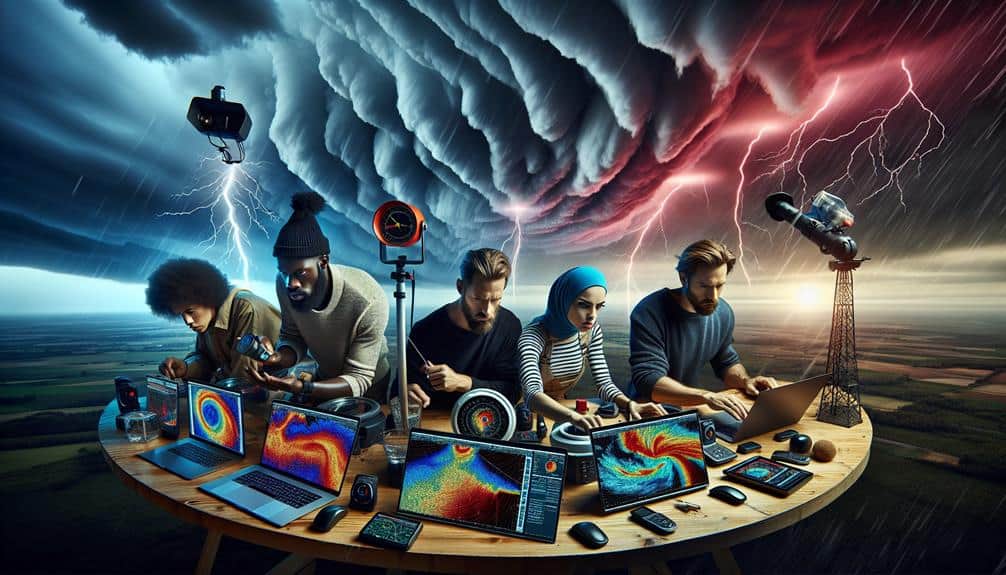By prioritizing real-time updates from dependable meteorological sources like NOAA and ECMWF, we track storm paths with high precision. We analyze weather patterns, using historical data and advanced tracking technologies like satellite imagery and Doppler radar for precise predictions. Our methods guarantee transparency and rigorous verification. Sophisticated algorithms and modeling systems interpret vast amounts of data, allowing us to predict storm intensity and movement accurately. Implementing these insights into safety protocols helps us activate evacuation procedures efficiently and disseminate critical information swiftly. There's further intriguing detail about these techniques and their effectiveness awaiting your discovery.
Key Points
- Utilize real-time updates from established meteorological institutions like NOAA and ECMWF for accurate storm tracking.
- Leverage satellite imagery and Doppler radar for precise monitoring of storm developments and movements.
- Analyze historical weather data and atmospheric dynamics to refine predictive models for storm paths.
- Implement safety protocols, including evacuation procedures and resource deployment, based on real-time data and predictive analytics.
Choosing Reliable Data Sources
When tracking storm paths, we must prioritize selecting data sources that offer high precision, real-time updates, and validated meteorological information. First, guaranteeing data precision is paramount. We need sources that undergo a rigorous verification process, where data is cross-checked against multiple dependable inputs. This secures that the information we rely on is accurate and trustworthy.
Source reliability is equally vital. We should use established meteorological institutions known for their robust methodologies and historical performance. Agencies like the National Oceanic and Atmospheric Administration (NOAA) and the European Centre for Medium-Range Weather Forecasts (ECMWF) provide highly dependable data. These institutions employ advanced technology and expert analysis, bolstering our confidence in their forecasts.
Information transparency is another significant factor. We need data sources that openly share their methodologies and update frequencies. Transparency allows us to understand how the data is generated and assess its reliability independently. It also guarantees we're not left in the dark about potential limitations or biases in the data.
Understanding Weather Patterns
To effectively track storm paths, we must first explore the intricacies of weather patterns, analyzing atmospheric dynamics and historical data to predict future movements accurately. By understanding the interplay of high and low-pressure systems, jet streams, and ocean currents, we can enhance our forecast accuracy. These elements drive weather patterns and greatly influence storm formation and trajectories.
We start by examining historical storm data, which provides a baseline for predicting future events. Patterns emerge from this data, revealing correlations between specific atmospheric conditions and storm paths. Additionally, we consider climate change, which is altering the frequency and intensity of storms. Rising global temperatures contribute to more volatile weather patterns, making accurate prediction increasingly challenging but crucial.
Our approach includes rigorous data analysis and model simulations. We use sophisticated algorithms to process vast amounts of meteorological data, identifying trends and anomalies. This data-driven methodology allows us to refine our predictive models continually.
Utilizing Tracking Technology
Utilizing advanced tracking technology, we enhance our ability to monitor and predict storm paths with greater precision. By using satellite imagery, Doppler radar, and computer models, we can achieve remarkable prediction accuracy. These tools provide us with essential real-time updates, enabling timely and well-informed decision-making.
Our use of satellite imagery allows for thorough observations of atmospheric conditions. High-resolution images from geostationary and polar-orbiting satellites help us detect cloud formations and storm developments. Doppler radar offers another layer of precision by measuring wind velocity and precipitation intensity. This data is vital for understanding the dynamics of storm systems and refining forecasts.
Computer models, driven by algorithms and historical data, simulate potential storm trajectories. By integrating data from satellites and radar, these models continuously update, increasing their predictive accuracy. The real-time updates we receive from these technologies guarantee that our forecasts remain current and reliable.
In today's fast-paced world, staying ahead of the storm is more important than ever. Our commitment to using cutting-edge tracking technology empowers us with the freedom to make proactive decisions, enhancing both safety and preparedness. With continual advancements, we can confidently navigate the challenges posed by severe weather.
Analyzing Storm Movement
Analyzing storm movement requires exact data collection and sophisticated algorithms to track changes in atmospheric conditions accurately. We rely on a combination of satellite imagery, radar data, and ground-based observations to gather extensive information about a storm's behavior. This data is then fed into advanced modeling systems, which use intricate algorithms to predict the storm's path and intensity.
To enhance our storm prediction capabilities, we employ various tracking techniques:
- Satellite Imagery: Provides a wide view of storm systems and their development over time.
- Doppler Radar: Measures wind speeds and precipitation, essential for understanding storm dynamics.
- Weather Balloons: Collect data on temperature, humidity, and pressure at different altitudes.
- Buoys and Ships: Monitor oceanic conditions, which influence storm formation and trajectory.
Implementing Safety Protocols

In the midst of an approaching storm, we implement safety protocols meticulously crafted to minimize risk and secure public safety. Our emergency response framework relies on real-time data and predictive analytics to make informed decisions. By utilizing advanced tracking systems, we can precisely forecast storm paths, enabling us to activate evacuation procedures and resource deployment effectively.
Our preparedness planning encompasses multiple layers of contingency measures. We establish clear communication channels to disseminate critical information to the public, guaranteeing everyone is well-informed and can make autonomous decisions for their safety. Emergency shelters are equipped and staffed, ready to provide refuge and essential services.
We also coordinate with local authorities and community organizations, bolstering our emergency response capabilities. This collaboration ensures a swift and efficient mobilization of resources, from medical aid to food supplies. Our teams conduct regular drills and simulations, refining our protocols to address any potential gaps.
Empowering individuals with knowledge and resources is a cornerstone of our strategy. We distribute preparedness kits and offer training sessions on storm safety. By fostering a culture of preparedness, we enable communities to face storms with confidence and resilience, safeguarding their freedom and well-being.
Frequently Asked Questions
How Do I Prepare an Emergency Kit for Storm Situations?
To prepare an emergency kit, we should gather essential food supplies, water, and first aid items. Don't forget to include a flashlight, batteries, and a robust communication plan to guarantee our freedom and safety during storms.
What Are the Signs of an Impending Storm?
When the calm before the storm hits, we should watch for early warning signs like sudden drops in temperature, darkening skies, and wind changes. Natural indicators like animal behavior shifts are critical for storm preparedness.
How Can I Protect My Pets During a Storm?
To protect our pets during a storm, we should identify nearby pet shelters and create detailed evacuation plans. Data shows that pet safety greatly improves when these measures are implemented, ensuring our pets' well-being and our peace of mind.
What Should I Do if I Get Caught Outside in a Storm?
If we get caught outside in a storm, we should immediately seek shelter in a strong building or vehicle. Taking safety precautions like avoiding tall objects and water sources is important to minimize risk and guarantee our safety.
Are There Specific Apps for Real-Time Storm Alerts?
Coincidentally, we've been exploring storm tracking. Yes, there are specific apps for real-time storm alerts. We recommend MyRadar, Weather Underground, and Storm Shield. They provide precise weather updates to help us stay informed and safe.

